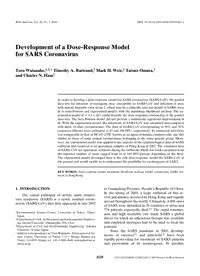
2010 Development of a Dose-Response Model for SARS Coronavirus PDF
Preview 2010 Development of a Dose-Response Model for SARS Coronavirus
Risk Analysis, Vol. 30, No. 7, 2010 DOI: 10.1111/j.1539-6924.2010.01427.x Development of a Dose-Response Model for SARS Coronavirus Toru Watanabe,1,2,∗ Timothy A. Bartrand,2 Mark H. Weir,2 Tatsuo Omura,3 and Charles N. Haas2 In order to develop a dose-response model for SARS coronavirus (SARS-CoV), the pooled data sets for infection of transgenic mice susceptible to SARS-CoV and infection of mice with murine hepatitis virus strain 1, which may be a clinically relevant model of SARS, were fit to beta-Poisson and exponential models with the maximum likelihood method. The ex- ponential model (k = 4.1 × l02) could describe the dose-response relationship of the pooled data sets. The beta-Poisson model did not provide a statistically significant improvement in fit. With the exponential model, the infectivity of SARS-CoV was calculated and compared with those of other coronaviruses. The does of SARS-CoV corresponding to 10% and 50% responses (illness) were estimated at 43 and 280 PFU, respectively. Its estimated infectivity was comparable to that of HCoV-229E, known as an agent of human common cold, and also similar to those of some animal coronaviruses belonging to the same genetic group. More- over, the exponential model was applied to the analysis of the epidemiological data of SARS outbreak that occurred at an apartment complex in Hong Kong in 2003. The estimated dose of SARS-CoV for apartment residents during the outbreak, which was back-calculated from the reported number of cases, ranged from 16 to 160 PFU/person, depending on the floor. The exponential model developed here is the sole dose-response model for SARS-CoV at the present and would enable us to understand the possibility for reemergence of SARS. KEY WORDS: Dose-response model; maximum likelihood method; SARS coronavirus; SARS out- break in Hong Kong 1. INTRODUCTION The causal pathogen of severe acute respira- tory syndrome (SARS) is a newly isolated coron- avirus (SARS-CoV) that first appeared in late 2002 1Environmental Science Center, University of Tokyo, Tokyo, Japan. 2Department of Civil, Architectural and Environmental Engineer- ing, Drexel University, Philadelphia, PA, USA. 3Department of Civil and Environmental Engineering, Tohoku University, Sendai, Japan. ∗Address correspondence to Toru Watanabe, Environmental Sci- ence Center, University of Tokyo, 7-13-1 Hongo, Bunkyo-ku, Tokyo 113-0033, Japan; tel: +81-3-5841-0644;
